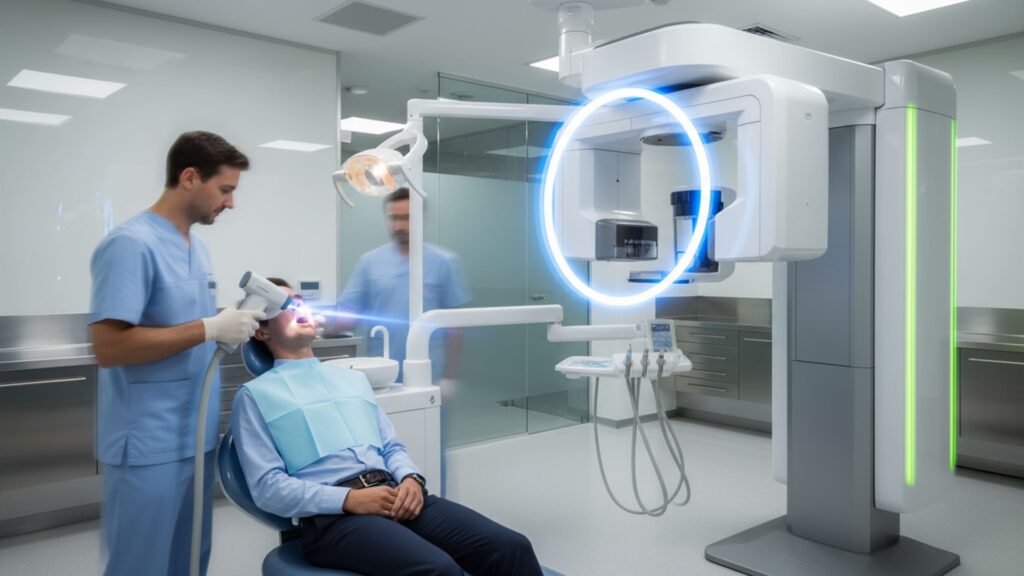Introduction
Investing in the best intraoral x-ray system isn’t just about upgrading equipment. It’s about upgrading your entire workflow, your diagnostic confidence, and your patient experience. Intra-oral radiography is the backbone of everyday dental diagnosis; yet, many clinics still struggle with outdated systems that slow down operations, frustrate patients, and result in inconsistent image quality.
With dozens of options available, how do you know which system is right for your practice?
In this article, we’ll discuss the essential features of digital dental x-rays that every modern system should offer so that you can make a confident, future-proof investment.
1. Image Quality and Resolution
Let’s start with what matters most: diagnostic accuracy. The primary function of any intraoral radiography system is to deliver crystal-clear images that reveal everything from early caries to bone loss and periapical pathology. If your system can’t consistently produce high-resolution, high-contrast images, it’s time to rethink your tools.
When comparing systems, look for:
- High DPI (dots per inch) or pixel resolution for detailed anatomical structures.
- A wide dynamic range to accurately display varying tissue densities.
- Advanced grayscale depth, which ensures subtle differences in enamel, dentin, and bone can be clearly distinguished.
2. Ease of Use and Workflow Integration
Even the most powerful imaging system is only as good as your team’s ability to use it efficiently. One of the most overlooked yet critical features of digital dental x-rays is workflow compatibility.
A modern intraoral radiography system should offer:
- Intuitive software with a minimal learning curve.
- One-click image capture and automatic storage.
- Seamless integration with your practice management software (PMS) or existing imaging platforms.
When your staff can operate the system confidently, it reduces retakes, increases productivity, and makes new team member onboarding much faster. Plus, fewer clicks and smoother workflows mean more time focused on patient care, not wrestling with technology.
Want a pro tip? Look for systems with customizable presets and automated image enhancements that reduce the need for post-processing. These usability features make a huge difference in daily efficiency, and are often what separate a good system from the best intraoral x-ray system.
3. Ergonomic Sensor Design
Comfort matters, both for patients and the team. An ergonomic sensor reduces gagging, discomfort, and awkward positioning, making the entire process smoother and faster.
Here’s what to look for:
- Slim, rounded edges for easier insertion and greater comfort.
- Multiple sensor sizes to accommodate both pediatric and adult patients.
- Durable yet lightweight build that stands up to repeated use and disinfection.
Systems like Tarsier X excel here. Their sensor holders are designed with real patient feedback, ensuring a better fit and less resistance during placement. The bite blocks are soft yet stable, making it easier for patients to hold still without discomfort. And when patients are more comfortable, they’re less likely to move, giving you a sharper, clearer image the first time.
4. Accurate Positioning Tools
Even the most advanced sensor won’t help much if the image is poorly aligned. That’s why precise positioning aids are essential when choosing the best intraoral x-ray system.
Key tools to look for include:
- Positioning rings and arms that simplify alignment.
- Angulation guides or built-in anglemeter tools for optimal cone beam positioning.
- Bite blocks with enhanced stability and minimal bulk for patient comfort.
Correct positioning reduces common errors like overlapping contacts, cone cuts, and distorted images. Not only does this reduce the need for retakes (saving time and reducing radiation exposure), but it also leads to more accurate diagnosis and treatment planning.
Tarsier X makes positioning foolproof with its patented anglemeter, offering real-time visual guidance so you can quickly line up the ideal shot. This means fewer adjustments, fewer retakes, and more confidence in your technique, especially for new staff or fast-paced practices.
5. Portability and Compact Design
Not every clinic has the luxury of spacious operatories, or the time to navigate bulky equipment. That’s why portability and space-saving design are becoming non-negotiable features of the best intraoral x-ray system.
Modern systems should be:
- Lightweight and easy to maneuver between operatories.
- Compact enough to fit seamlessly into tight clinical spaces.
- Designed for quick setup and teardown, especially in multi-chair environments.
6. Training, Support, and Updates
The purchase is just the beginning. What truly makes a system one of the best intraoral x-ray systems is the ongoing support behind it.
Look for:
- Comprehensive onboarding and training, whether virtual or in-person.
- Responsive technical support when issues arise.
- Software updates that enhance performance and add new features.
Conclusion: Choose Smart, Work Smarter
Choosing the best intraoral x-ray system isn’t just about specs. It’s about finding a tool that enhances every part of your clinical workflow, from diagnosis and documentation to patient comfort and team efficiency. The ideal system should combine sharp image quality, intuitive software, seamless integration, and thoughtful design, all while supporting you long after the install.
In short, it should work as hard as you do.
That’s why intra-oral radiography systems like Tarsier X stand out. With its blend of clarity, comfort, and cutting-edge usability, it reflects what modern dentistry demands: speed, precision, and reliability.
Ready to experience a smarter way to take radiographs?
Explore Tarsier X and see why it’s one of the best accessories for your intraoral x-ray systems.
Contact Us at +918867407944 to learn more.





